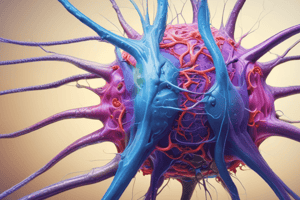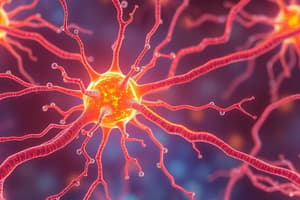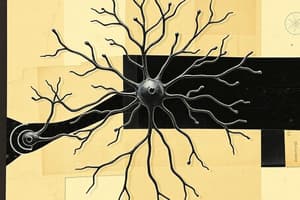Podcast
Questions and Answers
What is the primary role of the nervous system?
What is the primary role of the nervous system?
- To coordinate body functions using electrical signals (correct)
- To transport oxygen to body tissues
- To digest food and absorb nutrients
- To produce hormones for growth and development
Which of the following best describes the central nervous system (CNS)?
Which of the following best describes the central nervous system (CNS)?
- Nerves that extend to the periphery of the body
- Only the brain
- All the nerve cells of the body
- The brain and spinal cord (correct)
What type of neuron carries impulses from receptors to the spinal cord and brain?
What type of neuron carries impulses from receptors to the spinal cord and brain?
- Effector neuron
- Relay neuron
- Sensory neuron (correct)
- Motor neuron
What is the function of a relay neuron?
What is the function of a relay neuron?
Which neurone carries impulses from the CNS to effectors, such as muscles?
Which neurone carries impulses from the CNS to effectors, such as muscles?
Why do reflex actions bypass the brain?
Why do reflex actions bypass the brain?
In a reflex arc, which of the following is the correct order of events?
In a reflex arc, which of the following is the correct order of events?
What is the role of receptors in a reflex arc?
What is the role of receptors in a reflex arc?
Which muscle action is associated with pupil constriction in response to bright light?
Which muscle action is associated with pupil constriction in response to bright light?
What is the role of the motor neurone in a reflex arc?
What is the role of the motor neurone in a reflex arc?
What change occurs in the lens when focusing on a near object?
What change occurs in the lens when focusing on a near object?
What is the synaptic cleft?
What is the synaptic cleft?
Which type of photoreceptor cell is primarily responsible for color vision?
Which type of photoreceptor cell is primarily responsible for color vision?
Where are rod cells primarily located within the retina?
Where are rod cells primarily located within the retina?
How do neurotransmitters transmit impulses across a synapse?
How do neurotransmitters transmit impulses across a synapse?
When focusing on a distant object, how do the ciliary muscles and suspensory ligaments act?
When focusing on a distant object, how do the ciliary muscles and suspensory ligaments act?
Why does an impulse travel only in one direction at a synapse?
Why does an impulse travel only in one direction at a synapse?
What is the function of the radial muscles of the iris during low light intensity?
What is the function of the radial muscles of the iris during low light intensity?
Which of the following is not a sense organ?
Which of the following is not a sense organ?
Which part of the eye controls the amount of light entering?
Which part of the eye controls the amount of light entering?
How many different types of cone cells are there and what are the colors they are sensitive to?
How many different types of cone cells are there and what are the colors they are sensitive to?
Which statement best explains why the pupil constricts in bright light?
Which statement best explains why the pupil constricts in bright light?
What is the function of the lens in the eye?
What is the function of the lens in the eye?
Where are the photoreceptor cells located in the eye?
Where are the photoreceptor cells located in the eye?
Which of the following best describes the primary role of hormones in the body?
Which of the following best describes the primary role of hormones in the body?
Where are hormones primarily produced in the body?
Where are hormones primarily produced in the body?
Which of these is NOT a function controlled by the endocrine system?
Which of these is NOT a function controlled by the endocrine system?
During a 'fight or flight' response, which hormone is primarily released?
During a 'fight or flight' response, which hormone is primarily released?
Which of the following best describes the effect of insulin on blood glucose concentration?
Which of the following best describes the effect of insulin on blood glucose concentration?
What is a key difference between nervous impulses and hormones in terms of transmission?
What is a key difference between nervous impulses and hormones in terms of transmission?
Which of the following best represents the main role of homeostasis in a biological organism?
Which of the following best represents the main role of homeostasis in a biological organism?
How does the duration of hormonal responses typically compare to that of nervous impulses?
How does the duration of hormonal responses typically compare to that of nervous impulses?
What happens to cells when the level of glucose in the blood is too high?
What happens to cells when the level of glucose in the blood is too high?
What is the role of insulin in regulating blood glucose levels?
What is the role of insulin in regulating blood glucose levels?
What is the primary function of glucagon in blood glucose regulation?
What is the primary function of glucagon in blood glucose regulation?
Which of the following is NOT a consequence of low blood-glucose levels?
Which of the following is NOT a consequence of low blood-glucose levels?
What is the underlying cause of Type 1 diabetes?
What is the underlying cause of Type 1 diabetes?
How does glucagon affect cellular respiration?
How does glucagon affect cellular respiration?
What is the most direct consequence of not having enough insulin?
What is the most direct consequence of not having enough insulin?
What is the ultimate goal of homeostasis in maintaining blood-glucose concentration?
What is the ultimate goal of homeostasis in maintaining blood-glucose concentration?
What is the primary function of the hypothalamus in terms of regulating body temperature?
What is the primary function of the hypothalamus in terms of regulating body temperature?
If the body temperature drops below 37°C, which physiological response is least likely to occur?
If the body temperature drops below 37°C, which physiological response is least likely to occur?
What type of response is a plant's shoot growing towards light?
What type of response is a plant's shoot growing towards light?
Which of the following describes how auxins move over long distances in plants?
Which of the following describes how auxins move over long distances in plants?
Which of the following is a consequence of having a body temperature significantly above 37°C?
Which of the following is a consequence of having a body temperature significantly above 37°C?
If a plant's roots grow away from light, what type of response is that?
If a plant's roots grow away from light, what type of response is that?
What is unique about new treatments for disease that include stem cells and artificial pancreases?
What is unique about new treatments for disease that include stem cells and artificial pancreases?
Which of the following is a physiological response to an increased body temperature?
Which of the following is a physiological response to an increased body temperature?
Flashcards
Synapse
Synapse
A junction between two neurons where signals are transmitted.
Synaptic Cleft
Synaptic Cleft
A gap within a synapse where neurotransmitters are released.
Neurotransmitters
Neurotransmitters
Chemical messengers released by the presynaptic neuron to trigger a response in the postsynaptic neuron.
Presynaptic Neuron
Presynaptic Neuron
Signup and view all the flashcards
Postsynaptic Neuron
Postsynaptic Neuron
Signup and view all the flashcards
Cone Cells
Cone Cells
Signup and view all the flashcards
Rod Cells
Rod Cells
Signup and view all the flashcards
Fovea
Fovea
Signup and view all the flashcards
Nervous System: Functions
Nervous System: Functions
Signup and view all the flashcards
Central Nervous System (CNS)
Central Nervous System (CNS)
Signup and view all the flashcards
Peripheral Nervous System (PNS)
Peripheral Nervous System (PNS)
Signup and view all the flashcards
Sensory Neuron
Sensory Neuron
Signup and view all the flashcards
Relay Neuron
Relay Neuron
Signup and view all the flashcards
Motor Neuron
Motor Neuron
Signup and view all the flashcards
Reflexes
Reflexes
Signup and view all the flashcards
Reflex Arc
Reflex Arc
Signup and view all the flashcards
What is accommodation?
What is accommodation?
Signup and view all the flashcards
What are suspensory ligaments?
What are suspensory ligaments?
Signup and view all the flashcards
What are ciliary muscles?
What are ciliary muscles?
Signup and view all the flashcards
What are cones in the eye?
What are cones in the eye?
Signup and view all the flashcards
What are rods in the eye?
What are rods in the eye?
Signup and view all the flashcards
How do pupils control light?
How do pupils control light?
Signup and view all the flashcards
What is the pupil reflex?
What is the pupil reflex?
Signup and view all the flashcards
What is the endocrine system?
What is the endocrine system?
Signup and view all the flashcards
Hormones
Hormones
Signup and view all the flashcards
Endocrine system
Endocrine system
Signup and view all the flashcards
Endocrine gland
Endocrine gland
Signup and view all the flashcards
Adrenaline
Adrenaline
Signup and view all the flashcards
Homeostasis
Homeostasis
Signup and view all the flashcards
Nervous system
Nervous system
Signup and view all the flashcards
Insulin
Insulin
Signup and view all the flashcards
Glucagon
Glucagon
Signup and view all the flashcards
Blood Glucose
Blood Glucose
Signup and view all the flashcards
Diabetes
Diabetes
Signup and view all the flashcards
Type 1 Diabetes
Type 1 Diabetes
Signup and view all the flashcards
Type 2 Diabetes
Type 2 Diabetes
Signup and view all the flashcards
Glycogen
Glycogen
Signup and view all the flashcards
Body Temperature
Body Temperature
Signup and view all the flashcards
Hypothalamus
Hypothalamus
Signup and view all the flashcards
Shivering
Shivering
Signup and view all the flashcards
Vasoconstriction
Vasoconstriction
Signup and view all the flashcards
Sweating (Perspiration)
Sweating (Perspiration)
Signup and view all the flashcards
Vasodilation
Vasodilation
Signup and view all the flashcards
Tropism
Tropism
Signup and view all the flashcards
Phototropism
Phototropism
Signup and view all the flashcards
Study Notes
Coordination and Response
- The nervous system coordinates and regulates body functions via electrical signals (nerve impulses) along specialized nerve cells (neurons).
- This maintains homeostasis (a constant internal environment).
- The nervous system has two main parts:
- The central nervous system (CNS): Composed of the brain and spinal cord.
- The peripheral nervous system (PNS): Contains nerves outside the brain and spinal cord, carrying impulses to and from the CNS.
- Types of Neurons:
- Sensory neurons: Carry impulses from receptors to the spinal cord and brain.
- Relay neurons: Carry impulses between different parts of the central nervous system.
- Motor neurons: Carry impulses from the central nervous system to effectors (e.g., muscles).
Reflexes
- Reflex actions are involuntary responses to a stimulus to quickly remove the organism from a danger.
- The nervous impulse does not travel to the brain in a reflex action, as these reactions need to occur almost instantly.
- A reflex arc is the pathway followed by a nerve impulse during a reflex action:
- Stimulus detected by receptors.
- Sensory neuron carries impulse to the spinal cord.
- Relay neuron in the CNS passes the impulse to the motor neuron.
- Motor neuron carries the impulse to an effector (e.g., muscle), causing a response.
Synapses
- Synapses are junctions between neurons, forming a gap called the synaptic cleft.
- When an impulse arrives at a presynaptic neuron, neurotransmitters are released into the synaptic cleft.
- Neurotransmitters diffuse across the synapse, binding to receptors on the postsynaptic neuron.
- This triggers a nervous impulse in the postsynaptic neuron, transmitting the signal.
- Synapses ensure unidirectional transmission of impulses; neurotransmitters are present only in the presynaptic neuron, while receptors are only present in the postsynaptic neuron.
Sense Organs
- Sense organs are groups of receptor cells that respond to specific stimuli (e.g., light, temperature, touch, sound, chemicals).
- The eye is a sense organ that responds to light:
- Cornea: Refracts light into the eye.
- Iris: Controls the amount of light entering the eye.
- Pupil: Allows light into the eye.
- Lens: Focuses light onto the retina.
- Retina: Contains photoreceptor cells (rods and cones) sensitive to light.
- Fovea: Area in the retina with the highest concentration of cones, providing the clearest image.
- Optic nerve: Carries impulses to the brain.
Pupil Reflex
- The pupil of the eye adjusts to control the amount of light entering.
- Circular muscles and radial muscles work antagonistically to adjust pupil size based on light intensity.
Accommodation
- The eye can focus on both near and far objects by changing the shape of the lens.
- Ciliary muscles and suspensory ligaments work together to achieve this.
Rods and Cones
- Rods: Used for monochromatic night vision.
- Cones: Used for color vision in bright light.
Hormones
- The endocrine system uses hormones (chemical messengers) transported in the blood to regulate body functions.
- Hormones are secreted by glands and travel to target organs/cells to induce a response.
- Examples of endocrine glands and associated functions
- Adrenal gland: Produces adrenaline, involved in the "fight or flight" response.
- Pancreas: Produces insulin and glucagon, which regulate blood glucose levels.
- Testes: Produce testosterone, regulating male reproductive functions.
- Ovaries: Produce estrogen, regulating female reproductive functions.
Endocrine vs Nervous System
- Nervous impulses travel along neurons, while hormones travel in the blood.
- Nervous impulses are much quicker than hormones, while hormonal responses can be longer-lasting.
- The nervous system uses electrical signals, while the endocrine system uses chemical signals (hormones).
Homeostasis
- Homeostasis is the maintenance of a relatively stable internal environment despite external changes.
- This process is crucial for optimal cellular function.
Regulating Blood Glucose
- The body maintains blood glucose levels within a narrow range through the action of insulin and glucagon.
- Insulin lowers blood glucose by promoting glucose uptake by cells and glycogen synthesis.
- Glucagon raises blood glucose by stimulating glycogen breakdown.
Regulating Temperature
- Humans maintain a core body temperature of 37°C for optimal enzyme function.
- To maintain temperature, the body uses responses such as shivering, vasoconstriction, sweating, and vasodilation.
Tropic Responses
- Tropisms are directional growth responses by plants in reaction to stimuli,
- Examples:
- Phototropism : plants growing toward or away from light.
- Gravitropism : plants growing toward or away from gravity.
Studying That Suits You
Use AI to generate personalized quizzes and flashcards to suit your learning preferences.




